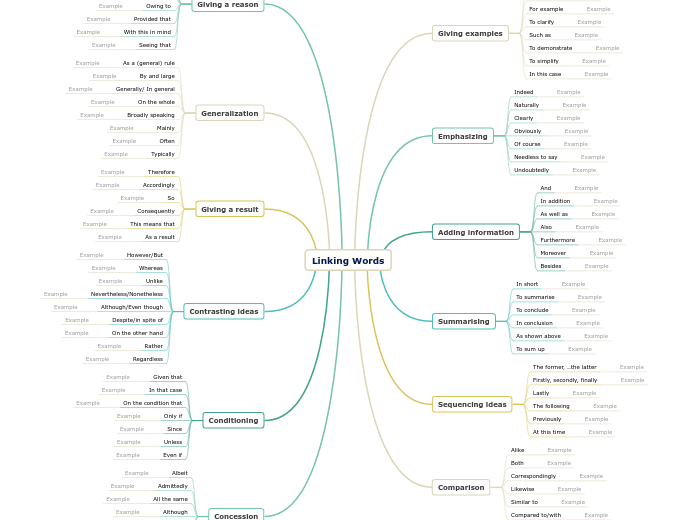Linking words examples
Use this mind map to have a view of the most usual situation when linking words are used and practice by creating various contexts.
Keywords: grammar, language, linking words


Ver más
Learn the categories of linking words from this template and complete them with linking words examples to better understand them.
Linking words help in connecting ideas and words in English. They are used to show contrast, connection, and condition between two things.
Linking words used for giving examples:
For instance
Namely
For example
To clarify
Such as
To demonstrate
To simplify
In this case
Linking words used for emphasizing:
Indeed
Naturally
Clearly
Obviously
Of course
Needless to say
Undoubtedly
Linking words used for adding information:
And
In addition
As well as
Also
Furthermore
Moreover
Besides
Linking words used for summarising:
In short
To summarise
To conclude
In conclusion
As shown above
To sum up
Linking words used for sequencing ideas:
The former, ..the latter
Firstly, secondly, finally
Lastly
The following
Previously
At this time
Linking words used for comparison:
Alike
Both
Correspondingly
Likewise
Similar to
Compared to/with
Linking words used for a concession:
Albeit
Admittedly
All the same
Although
And yet
Even so
Up to a point
Linking words used for conditioning:
Given that
In that case
On the condition that
Only if
Since
Unless
Even if
Linking words used for contrasting ideas:
However/But
Whereas
Unlike
Nevertheless/Nonetheless
Although/Even though
Despite/in spite of
On the other hand
Rather
Regardless
Linking words used for giving a result:
Therefore
Accordingly
So
Consequently
This means that
As a result
Linking words used for generalization:
As a (general) rule
By and large
Generally/ In general
On the whole
Broadly speaking
Mainly
Often
Typically
Linking words used for giving a reason:
Due to the fact that
Because of
Since
As
Owing to
Provided that
With this in mind
Seeing that
Linking words in any style of writing will help the reader to follow the flow of information.
These will show contrast, connection, condition between two things.
Use these words to accept a point or idea with reservation.
These linking worss are used to provide a condition to what has been stated.
However is the formal version of but. It is not normally used at the beginning of a sentence.
Although, despite and in spite of introduce an idea of contrast.
Therefore, so, consequently and as a result are all used in a similar way.
So is more informal.
These words are used to make a general statement.
Due to and owing to must be followed by a noun.
Because of is followed by a noun and can be used at the beginning or in the middle of a sentence. Since and as also mean because.
Use these words to show how things are similar.
These words are useful when you want to refer to one of two points, to list ideas.
The following is a good way of starting a list.
Use these words at the beginning of the sentence to give a summary of what has been said or written.
Ideas are often linked by 'and'. In a list, you put a comma between each item, but not before and.
Recommended not to start a sentence with also. Use instead In addition, or In addition to this.
These linking words are used to empashize a point.
The most common way to give examples is by using for example or for instance.
Namely refers to something by name.
Write phrases to exercise!
Los mapas mentales ayudan a realizar lluvias de ideas, establecer relaciones entre conceptos, organizar y generar ideas.
Sin embargo, las modelos de mapas mentales ofrecen una forma más fácil de empezar, ya que son estructuras que contienen información sobre un tema específico con instrucciones orientativas. En esencia, las modelos de mapas mentales garantizan la estructura que combina todos los elementos de un tema específico y sirven como punto de partida para su mapa mental personal. Son un recurso que proporciona una solución práctica para crear un mapa mental sobre un tema concreto, ya sea para los negocios o para la educación.
Mindomo le ofrece modelos de mapas mentales inteligentes que le permiten funcionar y pensar sin esfuerzo.
Topics descriptivos
Topics con texto de fondo
Rama por defecto
Eliminar los datos de la modelo
Puede elegir entre una variedad de modelos de mapas mentales de las cuentas empresariales o educativas de Mindomo, o puede crear sus propias modelos de mapas mentales desde cero. Cualquier mapa mental puede transformarse en un mapa de plantilla de mapa mental añadiendo más notas orientativas a uno de sus topics.